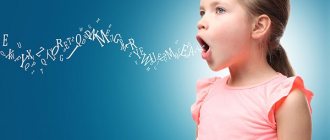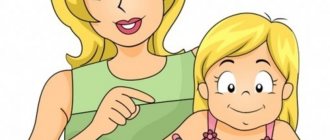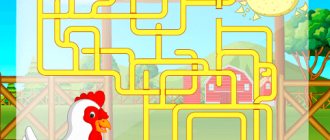A delay in speech development in a baby can lead to serious consequences. With the help of speech, a child develops emotional perception, more easily assimilates new information, and learns about the world around him.
Diagnosis of speech development is carried out at 3-4 years of a child’s life. If a speech therapist determines violations, the parents’ task is to begin correcting the defects as soon as possible. The younger the child, the faster the speech apparatus develops.
The importance of speech development
The task of parents is to create conditions for children to begin communication development as early as possible, learn to exchange emotions, and perceive surrounding phenomena and things. For babies who cannot yet speak, a nonverbal method of communication is extremely important, allowing them to show emotions to the people around them without words. So, yawning is a signal for parents that the baby is tired, a smile is a signal that the baby is in a wonderful mood. When parents correctly respond to the baby’s nonverbal messages, they contribute to his development and accelerate the transition to verbal communication.
When a child talks aloud about surrounding objects and phenomena, his speech ability is actively developing. A growing child gains the skill of creating logical chains, thinking, and moving from reasoning to action. Parents should devote enough time to communicating with their children in a favorable environment, because this is the main condition for speech development.
With properly developed speech, children have:
- developed thought processes;
- active functioning of the nervous system;
- ability to read clearly and quickly and write correctly;
- the ability to correctly perceive incoming information;
- high ability to plan and learn;
- clear and concise presentation of thoughts.
Indications and contraindications
Probe speech therapy massage is used for:
- dysarthria - impaired pronunciation due to damage to the nervous system;
- rhinolalia - disturbances of articulation and voice due to defects of the speech apparatus;
- voice problems;
- stuttering;
- alalia motor type;
- dyslalia – defective sound pronunciation with normal hearing and articulatory apparatus.
Massage exercises are contraindicated if:
- vomiting syndrome;
- inflammatory reaction in the nasopharyngeal area;
- mechanical damage to the tongue;
- blood pathologies of any origin;
- infectious damage to the body;
- tendency to allergies, accompanied by swelling of the mucous membranes;
- diseases whose symptoms are seizures;
- the patient’s oral cavity is injured or affected by fungus;
- open wounds on the hands of the massage therapist.
Setting hissing sounds with probes No. 3 and No. 5
To produce hissing sounds, use probe No. 5. The production begins with the sound “Ш”,
which is basic for the sounds of this phonetic group.
If the child pronounces the sound “C” correctly, the speech therapist asks him to open his mouth and inserts probe No. 5
wide end part under the tongue.
Then the child is asked to bring his teeth together and pronounce the sound s-s-s...
At the moment of pronouncing the sound with the help of a probe, the tip of the tongue is moved to the upper position.
By controlling the probe, the speech therapist regulates the degree of elevation of the tongue, achieving a clear hiss. The child's attention is fixed on the position of the tongue. However, until the new articulation is established, you cannot tell the child what sound he is making. Gradually, the baby gets used to the new articulation and pronounces the sound “Ш”
independently and for a long time.
Only after this inform the child that he has learned to correctly pronounce the sound “Ш”
and automate this phoneme in syllables and words.
The sound “Zh” is placed from the sound “Sh”
by turning on the voice or using
probe No. 5
in the same way, but from the sound “3”.
If the child pronounces the sound “R” correctly ,
you can put the sounds
“SH”
and
“Zh”
from this sound.
The child is asked to pronounce the sound “R” for a long time.
At the moment the sound is pronounced, the speech therapist brings
probe No. 5
to the lower surface of the front part of the tongue and inhibits its vibration.
When pronouncing the sound “R” in a whisper, the sound “Sh” is heard,
when pronouncing it loudly,
“Zh”.
Sound "Ch"
can be obtained from the soft sound
“TH”
by asking the child to pronounce the reverse syllable at with increased exhalation
.
At the moment of pronunciation, the speech therapist, using probe No. 5, slightly lifts and moves the tip of the tongue slightly back, achieving the desired acoustic effect.
Like all affricates, the “Ch”
is more easily automated in reverse syllables.
To produce the sound "Ш"
The child is asked to pronounce the syllable as in a drawn-out manner several times
.
Then the speech therapist inserts probe No. 5 under the tongue and, at the moment of pronouncing the syllable, slightly lifts the tongue and moves it back a little.
Sometimes, to evoke the sound “Ш”,
it is simply enough to ask the child to pronounce the sound
“Ч” for a long time.
Probe No. 3 is also designed to produce hissing sounds in some cases when the child has a fairly massive, large tongue. Producing sounds with this probe greatly facilitates the work of a speech therapist. By controlling the probe, the speech therapist lifts the child’s tongue and quickly develops the articulatory patterns necessary for pronouncing hissing sounds.
The techniques for producing sounds with probe No. 3 are similar to those performed with probe No. 5.
You can work either with the end part of the probe, changing the angle of its inclination, or with its transverse part with wavy teeth.
Then the hissing sounds produced using probe No. 5 or probe No. 3 are automated and differentiated.
Types of speech therapy massage
Speech therapy massage comes in several types:
- Classic or manual. It is carried out by smoothing, rubbing, kneading, shaking the problem area or the area around it.
- Spot. The specialist acts on bioactive points that are associated with problematic speech areas.
- Hardware. Involves the use of a vibration device.
- Probe. The impact is carried out through special devices - probes.
- Self-massage. The patient massages the problem areas independently.
Probe speech therapy massage
Massage carried out through probes helps prevent the worsening of speech impairment, prevents underdeveloped hearing, inhibition of gaining experience in vocabulary analysis, and a low level of vocabulary. After a course of procedures using probes:
- correct sound pronunciation is given;
- the tone of the articulatory muscles is restored;
- voice improves;
- breathing is normalized during pronunciation;
- the patient's psycho-emotional state improves.
Probe tongue massage
Massage of the tongue with probes lasts 5 minutes and is carried out several times a day. Before the procedure, it is advisable to do gymnastics to warm up the tongue muscles, including the following exercises:
- Swing. The tongue is stuck out and moved from one corner of the mouth to the other. The mouth is kept open.
- Watch. They open their mouth, lick their lips with their tongue in a circle in different directions.
- The lips stretch into a smile and the mouth opens. The tongue is placed on the lower lip and the air begins to blow out vigorously.
- Horse. Perform clicking movements with the tongue. The lower jaw should not move.
- Drummer. The lips are pulled into a smile, the mouth is parted. The tongue taps the edges of the upper incisors.
General recommendations for conducting
Massage with speech therapy probes is carried out in courses. Each course is designed for 8-10 sessions. It is allowed to do the procedure every day, but it is better - after 1-2 days, so as not to get muscle fatigue.
A total of 3-4 courses are carried out, with a break of 30-45 days. Sometimes one course is enough to normalize pronunciation. The duration of the session depends on:
- patient's age;
- complexity of the defect;
- child's reactions.
You need to start with 5 minutes. Then for 1-3 year old children, bring it up to 5-10 minutes, for 3-7 year olds – up to 15 minutes, for schoolchildren – up to 20-25 minutes. Each movement is done 30 times.
General recommendations for preparing for a massage should be followed:
- The room should be well ventilated, bright, clean. The atmosphere is cozy.
- It is necessary for the patient to be calm and peaceful. You should not carry out therapy if the baby is agitated, aggressive, or too depressed.
- If for any reason a child has a negative attitude towards probes, you should let him touch, look at the instruments, and play with them a little. You can say that they are magical, they teach you to speak.
- In case of an extremely negative (even hysterical) reaction, it is better to keep the sessions short – 5-10 minutes. At the same time, they begin by stroking the cheeks, lips, and tip of the tongue.
Logomassage for children at home
Massage that promotes speech development can be done at home. Parents should consult a speech therapist about exercise techniques and contraindications.
At home, massage the face and tongue with fingers and teaspoons, and perform breathing and articulation exercises.
Facial massage is based on smoothing, rubbing, kneading, which should not cause discomfort to the patient. Facial massage has a step-by-step technique:
- The forehead is smoothed from the middle to the temples, from the brow ridges to the ears. Then knead with light movements.
- The cheeks are wrinkled and stretched from the corners of the lips to the temples, from the cheekbones to the chin.
- The nose is smoothed and stretched with light movements. Then stroke the area from the wings of the nose to the corners of the lips.
- The lips are smoothed, stretched from the middle to the corners.
- The chin is smoothed from the middle to the corners of the mouth.
- The neck is stimulated with smoothing and kneading movements.
Today, speech therapy facial massage with spoons is popular. It is also carried out in stages. Masseur with spoons:
- Strokes the patient's temples.
- Strokes the eye socket area.
- Smoothes the cheeks.
- He rubs his temples with the convex surface of spoons.
- Rubs the area between the eyebrows with the convex surface of the cutlery.
- He rubs the nasolabial folds with the handles of the devices.
- Strokes lips with slight pressure.
- Kneads cheekbones and chin.
Spoons should be taken without sharp edges or bulges so as not to scratch the patient’s skin.
Setting whistling sounds with probes No. 1, No. 2 and No. 4
For lateral and nasal pronunciation of whistling sounds, when it is not possible to obtain a groove along the midline of the tongue, probe No. 1 is used.
First, using a probe, a groove is formed with the tongue protruding from the mouth. The child is asked to blow into the groove formed in the tongue and then this skill is reinforced, gradually eliminating mechanical assistance.
To make the sound “C”
The speech therapist invites the child, without sticking out his tongue, to open his mouth and smile. Then he places the probe on the front of the tongue in the middle, holding the tip of the tongue with the base of the loop of the probe against the lower teeth. In this position, the child is asked to blow on the tip of his tongue. At the same time, the speech therapist lightly presses the probe on the tongue, forming a groove for escaping air and achieving the desired acoustic effect. After a series of training in pronouncing the sound “C” with probe No. 1, the child is able to reproduce the necessary articulatory pattern and correctly pronounce the sound without mechanical assistance. Then the sound is automated based on the speech material selected by the speech therapist.
The sound “3” is placed in a similar way, but with the involvement of the vocal cords.
To eliminate interdental and subdental sigmatism, especially complicated by malocclusion, probes No. 2 and No. 4 are used. The sound is made from defective pronunciation. The child is asked to pronounce the sound s-s-s for a long time...
At this time, the speech therapist, pressing on the tip of the tongue with the loop of probe No. 2 or probe No. 4 placed across the mouth in front of the lower fangs, slightly moves the tongue away from the lower teeth into the depths of the mouth. A gap is formed, necessary to reproduce the whistling noise. Gradually, the mechanical assistance is eliminated and the child can independently pronounce the sound.
Sound "Ts"
can be obtained using probes No. 1 and No. 2 in two ways.
The child is asked to pronounce the sound combinations ts-ts-ts...
Simultaneously with the pronunciation, the speech therapist holds the tip of the tongue
with probe No. 1
or
No. 2
at the lower incisors (according to F.F. Pay).
Pressing the tip of the tongue against the lower teeth, the child is asked to pronounce the sound s-s-s for a long time with a soft attack...
At the same time, the speech therapist presses the tip of the tongue with probe No. 1 or No. 2, slightly moving it deeper into the mouth (according to O.V. Pravdina). By controlling the probe, the speech therapist achieves clear pronunciation of the sound.
Soft sounds are set from hard base sounds. Delivered using probes No. 1, No. 2 and No. 4
whistling sounds are automated and differentiated.
Novikova’s technique with non-speaking children
Most often, probes for speech therapy massage are used for dysarthric disorder, when the patient experiences great difficulty in pronouncing sounds. The probe type of massage was developed by the famous speech therapist Elena Viktorovna Novikova. The procedure is carried out using eight devices of different configurations, called probes.
Each probe is used for speech therapy massage for a specific purpose, affecting a specific area that needs correction. The specialist determines which area requires correction and with what force it needs to be pressed. The main thing is that the patient should not experience pain. If muscle hypertonicity is eliminated, the patient may feel slight muscle tension. In this case, to ease the discomfort, you should sit the baby in a soft seat or lay it on a comfortable surface.
Probe procedures correct speech technique and provide:
- voice improvement;
- normalization of conversational breathing;
- restoration of the psyche and state of the nervous system;
- tone of speech muscles;
- formation of correct sound pronunciation.
Speech production according to Novikova is technically simple and shows high efficiency. The specialist has developed a technique so that each probe stimulates a specific area of the articulatory apparatus: lips, tongue, cheeks, soft palate. During the procedures, these areas are restored.
The massage therapist pays attention to the condition of the patient’s facial muscles. Based on the level of muscle damage, the specialist prescribes the number of procedures necessary to normalize the condition.
Advantages and disadvantages
Massage with speech therapy probes, when performed correctly, gives good results. Its positive effect on the patient’s body is expressed in the following:
- speech development, improvement of sound pronunciation;
- voice normalization;
- restoring proper breathing;
- eliminating neurological disorders, improving the functioning of the central nervous system;
- normalizing muscle tone;
Universal oral massage can also be performed on healthy children at the initial stage of speech development. This will contribute to the correct formation of speech skills.
There are few disadvantages to probe massage procedures, but you shouldn’t turn a blind eye to them:
- If done incorrectly, the child's pronunciation may deteriorate.
- Massage manipulation alone is not always enough to restore speech. You cannot ignore other recommendations of the speech therapist: taking medications, physiotherapeutic procedures, articulation exercises.
Massage tools and technique
Massage should be trusted to a highly qualified and experienced specialist. It is advisable to use high-quality and safe probes from reputable companies. Parents must take their child to each procedure, and if classes are held at home, they cannot be missed.
The course of procedures lasts 2 – 3 weeks. After a 1.5-month pause, the course is resumed. The repetition of each exercise is 30 – 35 times. Sometimes one course is enough to normalize your speech. Children usually enjoy the procedures and do not experience any unpleasant sensations from the probes.
Massage therapists use the following speech therapy probes for massage:
- Forkhead (No. 1). The sharp end of the device is used to prick the tongue, lips, cheeks, and back wall of the mouth. As a result, the muscles begin to contract intensely. Gentle and gentle movements are made. After several sessions, the specialist may add rocking with the probe to the tingling sensation. The instrument is swung in different directions and in a circle for several seconds.
- Eight (No. 2). The instrument is designed to stimulate the lips, tongue and cheeks. The selected area of the body is rubbed from top to bottom and back using a loop-shaped base. The probe is not moved along the surface of the tongue, only pressure is applied to the organ and the loop on it is swung.
- Sleds (No. 3 – large, No. 4 – medium, No. 5 – small). Devices for stimulating the muscles of the tongue, lips, cheeks and back wall of the oral cavity differ in the size of the base, the force of pressure, and the coverage of the working area.
- Hatchet (No. 6). A tool for active work with the tongue, lips and cheekbones. It puts pressure on the muscles, rolls over them, restoring healthy muscle tone. With hypotonicity, the pressure is stronger, with hypertonicity, less pressure. Squeezing should not last more than 5 seconds.
- Cross (No. 7). The tool works exclusively with language. It puts pressure on the organ, pushes it back, due to which the lingual muscles actively contract.
- Pusher (No. 8). The probe is designed to alternately apply pressure on the tongue and relax the organ. The pressure lasts no more than 5 seconds.
Probe massage is highly effective if medical recommendations are followed. Novikova procedures are not performed on infants under 1.5 years of age. But manual speech therapy massage is allowed for children of any age. The main thing is to start correcting speech defects in a timely manner.
Probe kit
Speech therapy probes for producing sounds (authored by Rau) are not suitable for massage. A special set was developed by E. V. Novikova. It includes 8 main probes plus 4 additional ones. A patent for the development was received in 2000.
Probes are used to work with articulatory organs and the forearm. Stimulating the muscles of the dominant hand improves motor skills and promotes handwriting development.
The first tool is a fork , which looks like two blunt needles slightly apart to the side. A slight tingling sensation has an activating effect.
The second instrument is the eight . At the end there is a round loop that “grinds” the muscles.
The third, fourth, fifth tools are “sleighs” of different sizes. The shape of the probes resembles the rounded runners of a sled, hence the name. You can work with either side of the tool.
The sixth tool is a hatchet , which looks like two tightly pressed loops. Used for pressing on the surface of organs, sliding. Normalizes tone and increases muscle mobility.
The seventh is a cross, the loops are rounded and intersecting . It is used to stimulate the muscles of the tongue and develop its elevation.
The eighth tool is a pusher , a small loop raised at a right angle to the probe handle. Allows you to stimulate mobility and elasticity of muscles. When you press on the tongue, it creates tension; after the pressure is removed, the organ relaxes.
The ninth tool (additional) - tweezers , looks like two large rounded loops located parallel to each other. It is convenient to take the tongue with a probe and gently move it.
The tenth tool is a pull-up tool that looks like a low, wide frame. Used to stretch the frenulum.
The eleventh tool is a swan , a small loop, bent at the base, after which there is a small vertical section of the probe, which is bent at a right angle to the probe handle. Massages the palate, eliminates salivation.
The twelfth is sliding, looks like an elongated triangle with round corners. Used for sliding movements.
Some authors made their own adjustments to the set of massage probes. Vorobyova together with Krupenchuk created the author's set. It consists of 9 instruments. The creation of probes with different coils with small edges can be considered an innovation. This tingling sensation can effectively stimulate the nervous system.







